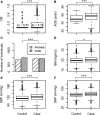Improving Disease Prediction by Incorporating Family Disease History in Risk Prediction Models with Large-Scale Genetic Data
- PMID: 28899997
- PMCID: PMC5676245
- DOI: 10.1534/genetics.117.300283
Improving Disease Prediction by Incorporating Family Disease History in Risk Prediction Models with Large-Scale Genetic Data
Abstract
Despite the many successes of genome-wide association studies (GWAS), the known susceptibility variants identified by GWAS have modest effect sizes, leading to notable skepticism about the effectiveness of building a risk prediction model from large-scale genetic data. However, in contrast to genetic variants, the family history of diseases has been largely accepted as an important risk factor in clinical diagnosis and risk prediction. Nevertheless, the complicated structures of the family history of diseases have limited their application in clinical practice. Here, we developed a new method that enables incorporation of the general family history of diseases with a liability threshold model, and propose a new analysis strategy for risk prediction with penalized regression analysis that incorporates both large numbers of genetic variants and clinical risk factors. Application of our model to type 2 diabetes in the Korean population (1846 cases and 1846 controls) demonstrated that single-nucleotide polymorphisms accounted for 32.5% of the variation explained by the predicted risk scores in the test data set, and incorporation of family history led to an additional 6.3% improvement in prediction. Our results illustrate that family medical history provides valuable information on the variation of complex diseases and improves prediction performance.
Keywords: Genetic variability in complex binary traits; Liability threshold model; family history; penalized prediction model; risk prediction in complex disease.
Copyright © 2017 by the Genetics Society of America.
Figures




References
-
- Aekplakorn W., Bunnag P., Woodward M., Sritara P., Cheepudomwit S., et al. , 2006. A risk score for predicting incident diabetes in the Thai population. Diabetes Care 29: 1872–1877. - PubMed
-
- Chatterjee A., Lahiri S. N., 2011. Bootstrapping Lasso estimators. J. Am. Stat. Assoc. 106: 608–625.
-
- Committee on Diabetic Twins, Japan Diabetes Society , 1988. Diabetes mellitus in twins: a cooperative study in Japan. Diabetes Res. Clin. Pract. 5: 271–280. - PubMed
Publication types
MeSH terms
LinkOut - more resources
Full Text Sources
Other Literature Sources
Medical

